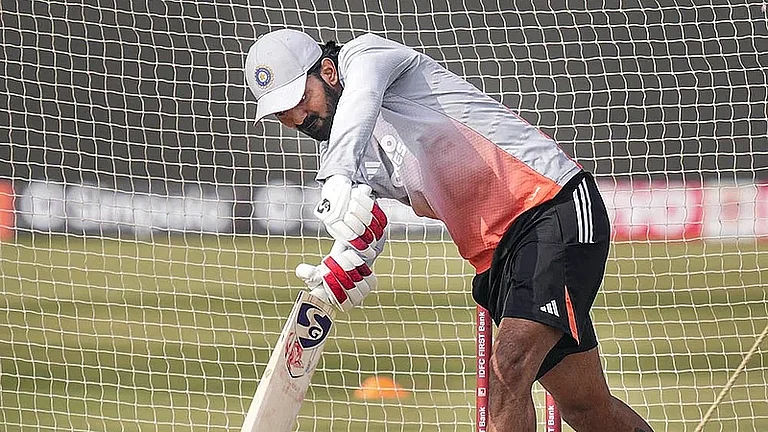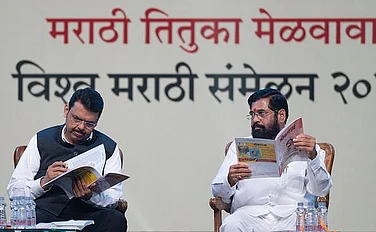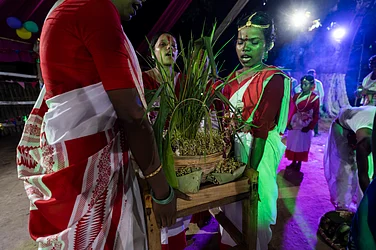At the centre of a large roundabout in Beed, the town’s singular such landmark, stands Chhatrapati Shivaji, resplendent in his sculpted copper glory, astride a purposeful horse, flashing his sword. Stretching in four directions from this roundabout are the four main roads of the town. Located on one of them, Subhas Road, are the following: a leading nationalised bank’s Beed branch (a non-MICR one), a branch of the Maharashtra Grameen Cooperative Bank, and a couple of doors away, a rather large cubbyhole that teaches young job aspirants ‘Typewriting and Shorthand courses’ which the economically liberalised urban India graduated from nearly two decades ago.
Their alignment is, perhaps, purely coincidental. Or they could be read as the surreal linear narrative of Beed, the administrative HQ of the district by the same name in central Maharashtra, a town that simultaneously displays symbols of a 1980s semi-urban setting—ground-plus-two structures on main roads, bullock carts amidst dusty state transport buses, large offices of the collector, SP and DM—against post-liberalisation markers like auto and electronic goods showrooms, glass-facade buildings and mobile phone stores and users. Barely 10 km away, in any direction, is the rural face of the district—villages that still do not have reliable drinking water, sanitation, transport or communication facilities. In fact, Beed town itself is not yet connected by rail or air; the nearest railhead and airport at Aurangabad are a good 3-4 hours by road.
Beed district is home to nearly four lakh people (1.4 lakh of whom live in the town itself) and was listed as one of the 100 most economically backward districts in the early ’90s and placed in ‘Category B’ of the country’s industrially backward districts in 1994 by a central government study group. It’s a living manifestation of the hits and misses of the trickledown theory. “A few good- looking cars on the main road and mobiles in many hands doesn’t mean progress,” says local historian and teacher, Dr Satish Salunkhe. “Beed remains as undeveloped or under-developed as it was in the 1980s. It’s hardly on anyone’s radar in Mumbai or Delhi.”
The sparsely populated Maharashtra Industrial Development Corporation (MIDC) site, off Jalna Road, is living testimony to lost opportunities. Large plots lie vacant, modest-sized industrial units sport huge locks and rusted gates, roads are barely one-lane wide. Still, deep inside the MIDC is Shridutt Plastics, a Rs 10-crore company that supplies all varieties of plastic pipes to hard-won clients as far away as Pune and Bangalore. Owner and first-generation entrepreneur Hanumant Upre says, “Now there are mobiles. But the rest of the infrastructure is still as bad—Speedpost still takes 3-8 days to major cities, there’s load-shedding, water is supplied once in three days and charged twice what I would pay in Pune, procuring any certificate or licence means two months of regular trips to Aurangabad. Who will want to come here and set up industry?”

Everyone’s gone Locked doors, a constant reminder at Imampur village, Beed district. (Photograph by Dinesh Parab)
An estimated 60 per cent of the SSI units in Beed are “sick”; cotton-weaving and leather units rank high among them. Given the plentiful—though unorganised—local produce of cotton, sugarcane, milk and fruit like custard-apple, the scope for textiles, weaving and agro-based industries is immense. “But all this is either wasted or sent out as raw material,” rues Satyanarayan Lahoti, president of the Marathwada Vyapar Mahasangh. Poverty in Beed was officially nearly 40 per cent in ’93-94, it hasn’t significantly decreased since. Beed is geographically well positioned to be the gateway to the Marathwada region (comprising eight districts) of the state. However, industry-led development, say local entrepreneurs, is not feasible until Beed features on the railway map of the country and road connectivity improves.
A rail route linking Beed to Aurangabad and/or Parli-Vaijnath at the other end is a 40-year-old demand, one that’s taken up steam since the ’80s when the late Kesarbai Kshirsagar was elected thrice to the Lok Sabha; her son Jaydutt is now a Maharashtra cabinet minister and Beed’s guardian minister. Beed has had powerful spokespersons in the last two decades—the late Pramod Mahajan of the BJP and present MP Gopinath Munde; the Marathwada region has had three CMs, including the late S.B. Chavan, son Ashok Chavan and Vilasrao Deshmukh. Yet, despite the political clout, no one’s been able to connect Beed to any of the nearest railheads. “There have been three ‘fake’ railway station inaugurations that I know of,” remarks Santosh Manurkar, editor of the popular local Marathi daily, Zunzar Neta.
Jaydutt Kshirsagar admits that the district “hasn’t really benefited from the liberalisation and globalisation policies. Beed has remained the labour-providing district for the sugar lobby in western Maharashtra”. The “labour-providing district” is a tag that infuriates many in Beed. It is, unfortunately, the reality that sustains the local economic edifice.
The lost human resource is mainly to blame for Beed’s inability to jump onto the growth bandwagon. Every year, for 6-7 months, villages across Beed district empty out by half as families pack up meagre belongings, pull children out of one-classroom schools, lock up their houses and set forth on bullock carts or trucks to sugarcane fields and sugar factories in the western Maharashtra region, a few hundred km away. The economic migration cycle begins at the end of summer when the area’s labour contractor-cum-moneylender comes calling with an ‘uchchal’, a unilaterally decided take-away amount, that ranges between Rs 40,000-80,000 per ‘koyta’ (literally a sickle, but meant in local parlance as a husband-wife team who will cut the cane and load it for factories). Those who take the uchchal must pack up and leave immediately after Diwali that year; they spend the next six months in abysmal temporary conditions around sugarcane fields and factories, battle the winter chill often in the open, and return home around Gudi Padwa in March-April at the end of the sugarcane crushing season.

To the slave mills Labour contractor/moneylender Navnath Salunkhe. (Photograph by Dinesh Parab)
“I don’t know which village or which factory. I don’t know how much uchchal was given. I only know that we have to go like this every year,” says Mankarna Kadam. She and husband Baburao are one such koyta from Imampur village, on the outskirts of Beed town. Back home for a family/village deity worship, they are being hustled by their contractor to return to work soon. “I send 80-100 koytas every year,” says contractor Navnath Salunkhe. Contractors get their commission both from the hired koytas as well as the sugar factory/farm they service. And, in classic exploitative economic model, a contractor is also the money-lender to the villages that he hires from. This effectively means villagers are indebted to him, some so heavily that they barely get to keep half of their uchchal each year; the rest is loan repayment. “Usually a debt cycle goes on for 10-12 years and covers two generations, which means they cannot even hope to get trained for industrial jobs,” points out local journalist Vasant Munde. Those who take an uchchal but don’t show up at the factory are often found dead.
Nearly half of those who migrate have land, but they cannot grow crops thanks to the uchchal system. Those who grow cotton switched to Bt crop a couple of years ago—Beed has already registered a few debt-related farmer suicides. A majority of the koytas are Dalits and scheduled caste people, says rights activist Ashok Tangde. “There’s a machine that sugar factories can employ to harvest cane, but the Marathas have to show their might to Dalits,” he says, not without bitterness. “This is nothing but bonded labour; it’s illegal and it’s also destroying the economic potential of Beed,” says his wife and fiery women’s leader Manisha Tokle. The couple has seen further entrenchment of oppression and violence against women, as men force their abandoned wives to resume a ‘marital life’ only because they have accepted an uchchal. “The woman has no say at all. If she protests, she is beaten. We regularly get such cases,” says Tokle.
There’s another aspect to this stagnant migration economy in Beed, the classic demonstrative effect. Those who travel see lifestyles in better-off regions; their aspirations grow. TV sets and mobile phones are must-have gadgets, even in villages. “But gadgets and exposure haven’t made an iota of difference to our casteist structures, people still refuse to sell us a plot on the main road because we are Dalits,” says Tokle. Casteism is a constant undertone in other ways as well, determining where people live, which school or college they will send children to, which of the handful of hotels they will eat out at and, most importantly, what work they will do. The Maratha vs Dalit/SC/OBC paradigm reigns strong. The Chhatrapati Shivaji statue, in the centre of Beed town, then, is not merely a landmark—it’s also a constant reminder of Maratha economic control.


























